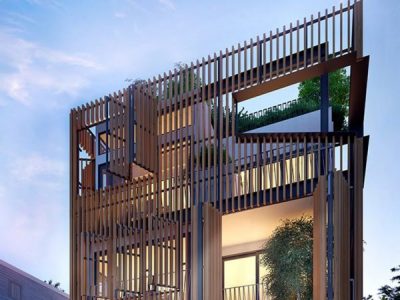With population growth, housing affordability / scarcity, and land shortages, Brisbane’s skyline is changing with construction heading up not out. Many of these new developments will be high-rise residential apartment towers. So, whilst these high rise resi’s are being built, the question arises whether they are being designed in a way that factors not only on the housing crisis but also on addressing sustainability and climate change. So, we turn our attention to the use of glazing on our high rise residential (and commercial) buildings and the efficacy of this glass with climate change in mind.

High rise residential buildings and glazing
A big problem of climate change for construction is the type of poor quality heat-strengthened glass we currently use on our high rise facades. Whilst they are good at resisting strong wind loads, from a thermal perspective, they are not of the same quality as triple-glazed panels that can be found on high-rise buildings in other parts of the world, such as the UK, Europe and America. Our glass simply doesn’t offer the same level of thermal performance. Triple glazing holds in the heat and/or cool air much better and reduces the amount of energy used and wasted. According to the latest reports, 47% of heat loss/gain occurs from a building’s windows.
Single, double, triple glazing – What’s the difference?
A single-glazed window is a single piece of glass in a frame, as is found in most Australian homes. A double-glazed window has two pieces of glass separated by a gap filled with gas, sealed, and improves insulation by as much as 80%. A triple-glazed window has three pieces of glass, with the third pane sitting between the other two, and similar to double-glazed windows, has gaps containing gas when sealed, but this time including two air-locked areas, which improves insulation by a further 50% compared to that of a double glazed window.

How much glass is enough? – High rise building facades
Further to our glass having a lack of thermal performance, another issue is the amount of glass used on our high-rise facades. Should we question why we use so much of it and whether other materials could be used in conjunction with the glazing during the design phase, in a move away from glass that is floor to ceiling? An example is the Cornell Tech Building in New York, where the glazing only forms 23% of the façade, is climate-friendly and has kept its aesthetics.
Using less glazing is important, even if it’s a more thermal type of glazing, because it can have the unintended consequence of acting like a mirror and deflecting heat and radiation back to the street level, especially when looking at high-rise buildings surrounded by little greenery.
So, a good way to futureproof new buildings is to invest more thought into the impact of climate in the design phase.
Climate-adaptive design
UNSW Sydney provides a good example of climate-responsive design, as seen with the Al Bahar Towers in Abu Dhabi, showing that a building can be resilient to shifting, often unpredictable climate conditions by constructing more energy-efficient and adaptive infrastructure.
When first viewed, the façade of this building may be mistaken for purely beautiful aesthetic design, but cleverly, it caters for solar and glare efficiencies via an opening and closing external ‘curtain’ that automatically responds to the sun’s movements, equating to greater energy savings.

(Source: Karen Cilento, “Al Bahar Towers Responsive Facade / Aedas” / Leanne Hew, UNSW Sydney 28 August 2023)
Takeaway
Australia is behind the rest of the world for buildings that are energy efficient. Even though this is slowly changing as we become more aware of our use of construction materials and their impacts, much still needs to occur to attain energy-efficient and resilient buildings that stand the test of time with changing climate patterns.
Undoubtedly, we’ll have to start designing smarter buildings to cater to climate change’s impacts, as our buildings are energy-intensive. We could look more towards incorporating overseas glazing methods and ways of using less floor-to-ceiling glass on high rise buildings in general. Also, incorporating more vertical gardens in our builds and learning more about climate-adaptive design.
With so many proposed high rise residential buildings earmarked to meet Brisbane’s housing crisis, now would be a good time to incorporate climate change best practice into the designs.
(Sources: PodMarket; Metropolis Magazine; The Age, LouProjects; The Fifth Estate; UNSW Sydney; ScienceDirect)
(Note: The information compiled to write this article is made in good faith only and derived from sources believed to be reliable and accurate at the time of publication).
Looking for your next construction job? Search our current construction roles here, or to chat with our team about securing your next opportunity, get in contact with us through our Contact Us page.
Receive our updates straight to your inbox



